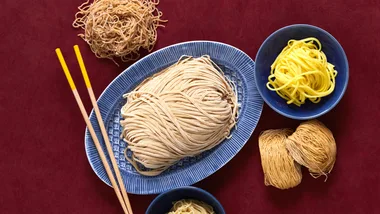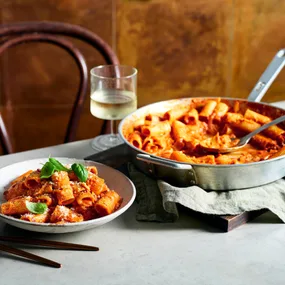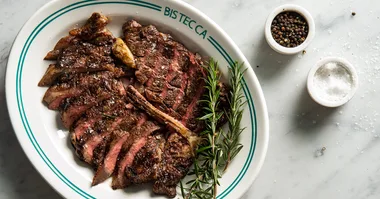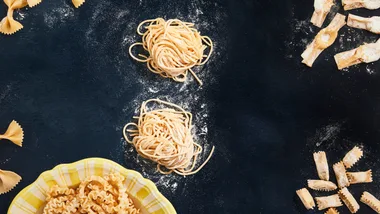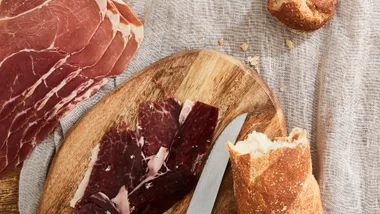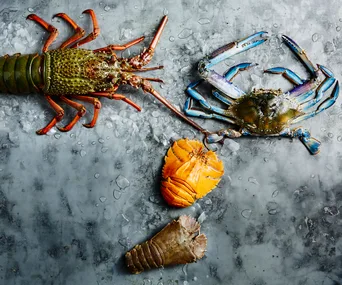You probably have a fair idea of what cheeses or producers you like. You might even have some favourites you turn to regularly. But varieties and producers aside, how do you make sure you’re purchasing great cheese every time? Bronwen Percival, a cheesebuyer at Neal’s Yard Dairy in London, and food and wine writer Francis Percival believe it’s not hard to create an impressive cheeseboard once you know what to look for at the cheesemonger. Here they share what they’ve learned from many years of talking to producers and tasting and smelling everything from fresh curd cheeses to clothbound cheddars.

Bronwen and Francis Percival
The best cheese, like the best wine, is that which most clearly expresses the unique terroir of a single farm. It will taste unlike any other cheese. That’s because cheesemaking is essentially an exercise in managing ecologies, from the farmers who oversee the plants and animals on a dairy farm to the cheesemaker who manages the microbes that ferment the milk and ultimately ripen the cheese. In our book, we make the case that cheese is the best agricultural product at allowing you as the consumer to taste every farming decision that’s gone into its production, far better even than wine.
But how do you know whether you’re getting the best example of a particular variety of cheese? It comes down to the information that’s right in front of you. Simply looking at the cheese, tasting it and talking with your cheesemonger will tell you everything you need to know.
Take a look at the rind of the cheese
The best cheeses wear their biodiversity on their sleeves or, to be exact, their rinds. Will Studd’s excellent primer for GT on judging a cheese by its rind covers the different types of rinds cheesemakers use and what a buyer might look for in specific types of cheese. Here are some golden rules to adhere to, no matter the type of cheese:
Avoid cheeses that have been matured while sealed in plastic or coated in wax. These coverings keep out the oxygen needed by yeasts and moulds in order to grow and form a rind.
Instead, look for cheeses with natural rinds, be they clothbound hard cheeses, sticky, pungent washed-rinds, or mould-ripened soft cheeses. Studd’s article runs through what rinds to look for (and what to avoid) in most major cheese types.
Choose rinds where you can spot communities of different bacteria and fungi living side-by-side. For instance, great brie or camembert should strike a balance between a thin dusting of white-coloured mould, some cream-coloured wrinkles, and maybe even a pinkish blush between the folds of the rind when fully ripe, as opposed to the flat white rind that’s often seen. Diversity leads to complexity – such a cheese will have a far more interesting flavour than one with a papery white rind.

Wheels of Remeker cheese ageing
Pay attention to the paste
The colour of the paste is important, as it holds clues about the diet of the animals whose milk went into the cheese. Cows that feed on grass provide milk with a yellower colour than those that are fed maize or other high-energy, starchy feeds.
Beware, though, that this clue only applies to cow’s milk cheeses: goats and sheep always produce milk with a bright white colour, regardless of what they’ve been eating.
When buying soft cheeses, examine the texture of the paste. It is tempting to gravitate toward runny cheeses, but this is not always a sign of quality. Some cheeses – including Swiss Mont d’Or or Portugal’s Serra da Estrela – are meant to liquefy when ripe; these cheeses are sold whole and are best served with a spoon. Brie-style cheeses, in contrast, should be shiny and supple but stand their ground. Dripping cheese, especially where the rind appears to be slipping off, is a sign of technical problems in the make.
Ask to try the cheese
Smelling and tasting are key parts of selecting a cheese. Don’t hesitate to ask for a sample if one isn’t offered straightaway.
Tasting will help you gauge the ripeness of the cheese. Underripe cheese tastes dull and bland, while the flavour and aroma of perfectly ripe cheese is vibrant and direct. Of course, it is possible to have too much of a good thing: as cheese moves past its prime, its flavour becomes indistinct and muddy. Finally, it begins to reek of ammonia. Just like wine, all very old cheese tastes much the same.
As you taste, consider the flavour of the cheese in the context of the style. Flavours like sweetness in a cheddar mean that the cheesemaker is relying on cultures with flavour-additive properties rather than allowing the raw materials to speak for themselves.

Surface-mould-ripened soft cheese
When trying cheese, you should also look for complexity. Cheese from animals that have been fed solely on pasture rather than grains and other concentrated feedstuffs has far more variation in taste, as it reflects the conditions of the place where the animals graze, a bit like terroir and wine. Fermentation techniques that make the most of this natural biodiversity also lead to cheese that tastes more complex. This is not just a feel-good story; it is a result demonstrated repeatedly by agricultural scientists.
A good general rule is if the flavour of a cheese is one-note, it is not a high-quality cheese.
Talk to your cheesemonger
One of the biggest advantages of buying cheese from a person, as opposed to picking it up in the dairy aisle, is the opportunity to talk to someone about what you’re looking for. Your cheesemonger will be delighted to answer your questions, and can tell you the about the farming practices, the location of the farm and whether the cheese is made from the milk of a single herd. And if they do not immediately know the answers to your questions, they can speak with the cheesemakers and get back to you.
Bronwen and Francis Percival’s Reinventing the Wheel: Milk, Microbes, and the Fight for Real Cheese (Bloomsbury, hbk, $32.99) is out now.
WHAT TO LOOK FOR WHEN BUYING CHEESE
Taste
Is the taste dull or bland, and therefore underripe?
Does it taste like a cheddar, for example, should taste?
Avoid one-note flavours and choose cheeses with complexity.
Appearance
Stay away from cheeses that are matured in plastic or wax coverings.
Be wary of thick chewy blankets of white mould.
For brie, camembert and lactic goat’s cheeses, look for thin delicate rinds that adhere neatly to the cheese.
Is the paste a pale yellow in cow’s milk cheeses?
Is the paste runnier than it should be? Only a select few cheeses should ooze.
Smell
Avoid cheeses that smell like ammonia – they’re past their prime.
When you smell, look for complexity and length.
Remember that different varieties of cheese have their own distinct aroma.
.jpg?fit=900%2C676) Getty Images (main), all other images courtesy of Bronwen and Francis Percival
Getty Images (main), all other images courtesy of Bronwen and Francis Percival

